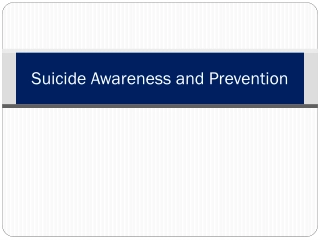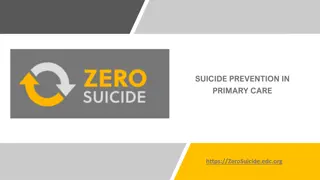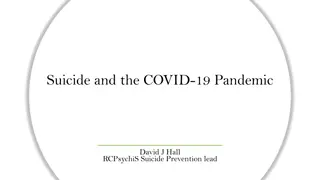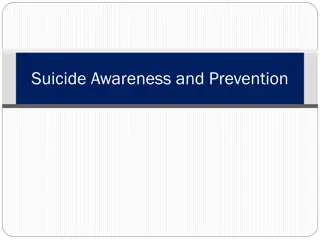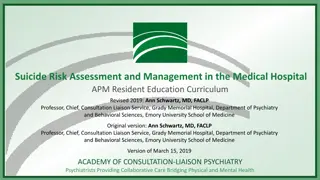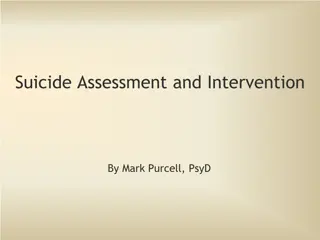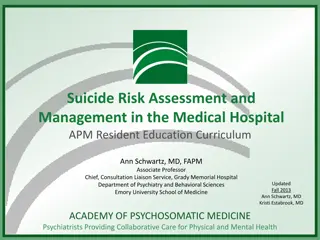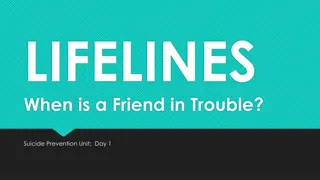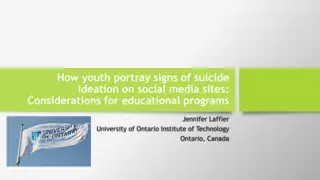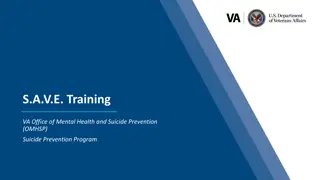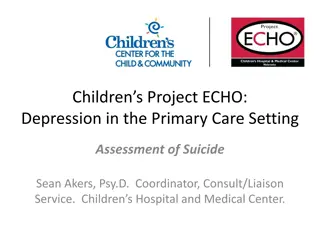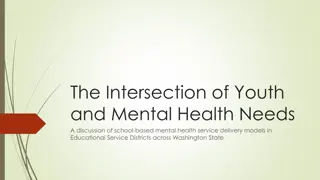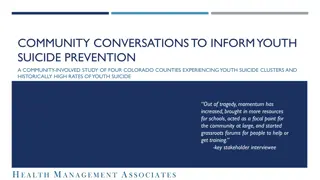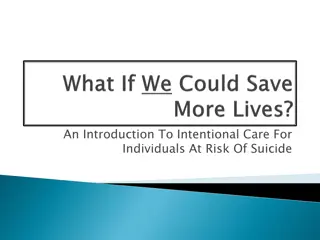Understanding Suicide Risk Assessment in Therapy
Suicide assessment in therapy is crucial as suicidal ideation can present unexpectedly in any patient. Therapists must be prepared for evaluation without giving unsolicited advice or reasons to live. Key factors in suicide assessment interviews are essential. Depression is a significant factor in suicide, with specific patterns and behaviors indicating risk. Factors such as gender, age, race, and religion can also influence suicide risk levels, but individualized assessment is crucial.
- Suicide risk assessment
- Depression and suicide
- Therapist preparation
- Key factors
- Suicide risk factors
Download Presentation

Please find below an Image/Link to download the presentation.
The content on the website is provided AS IS for your information and personal use only. It may not be sold, licensed, or shared on other websites without obtaining consent from the author. Download presentation by click this link. If you encounter any issues during the download, it is possible that the publisher has removed the file from their server.
E N D
Presentation Transcript
SUICIDE ASSESSMENT CHAPTER 9 Uzm. Psk. zlemAtao lu
There is no way to know beforehand that whether your patient is suicidal or not Even, your first patient can be suicidal so you should be prepared for assessment and work on your own anxiety and manner of working with a suicidal patient You should not be giving lectures of the joy of living, advice, reasons why s/he should live, etc. Working on suicide can affect you as a therapist, as well. So you should be really careful about your emotions and reactions as well
KEY FACTORS OF THE SUICIDE ASSESSMENT INTERVIEW There are a lot of theories on how suicide should be assessed, there is no consensus We will focus on the basic key factors as a beginning
Suicide Risk Factors and Their Evaluation There is no single factor that predicts suicide disposition There is no obvious reason why some of the patients with the same severity of depression commit suicide and others do not We will list the risk factors but remember not having/showing these factors does not mean the patient is free of suicide drives
Depression: There is a relation between depression and suicide. It is very common to have depression/depressive patterns before suicide this is why depression is described as fatal Clinically % 5 10 of the patients with depression attempt/commit suicide and the disposition is correlated with the severity Not all of the patients with depression show disposition to suicide There are several variables that predicts suicide behavioursof patients with depression. Some of these factors are: Severe anxiety Anhedonia Insomnia Repetitive self destructive behaviours Physical/Sexual abuse End of a relationship Despair w/ distorted cognitive appraisals
Gender, age, race, religion, seasonal changes:Suicide rates of males are 3 4 times higher in men than women. Young boys and elder men are in higher risk than young girls and women. However, women s attempts are 3 times higher than men Black women show lower risk than old Asians Race and religion can sometimes lower the suicide risks Darker countries have a higher risk of suicide Sweden, Finland, Norway Suicide rates depend on culture, ethnicity, race, religion but each group has its own patterns and these rates does not mean you will assess patients according to these rates each patient deserves focused, careful assessment
Social isolation and interpersonal factors: People who do not have others around, cannot satisfy the need of belonging, cannot create a relation show more risks of suicide Unemployment, social isolation, lack of productivity, physical inability increase the risk as well Separated, widow, living separately people are at high risk group. Never married people show 2 times more suicide rate than married ones Feeling belongingness and helping to family, friends and others decrease this risk So, single, feeling non belongingness, older than 70 men form the highest risk group
Physical health: Frequent major surgical operations, chronic pain related diseases, decreased body functions, fear of death and pain, paralysis, loss of social support, social isolation caused by disease increase the risk factors The severity of the disease, physical pain and prognosis are the main predictive factors of suicide. Patients with medical diseases show high risk of suicide right after discharge Personal resources: Sheltering, food, transportation, clothes, medical support, physical and mental resilience, productive activities, meaningful and supportive relationships, appropriate defense mechanisms decrease the risk of suicide. Living alone also increases this risk. Isolation and loneliness feelings can occur in crowded fields, as well. These feelings are more important than the physical factors so you need to examine very carefully. People who lost someone recently also shows higher risk loss of job, status, loved one, physical health and body mobility, pet
Substance abuse: Under the effect of alcohol or substance people behave more impulsive (inhibition disappears). Since suicide is accepted as an impulsive behaviour, use of alcohol/substance increases the risk. Regardless of suicide plans, during the real action , people are more impulsive it gives more courage Mental disorders & Psychiatric treatment: High risk groups are MDD, BD, schizophrenia, substance use/abuse/addiction, BPD, APD, anorexia nervosa. Tense, agitation, cognitive distortions, problematic social relationships, despair are common factors of these disorders. Especially, the attempts of personality disorders seem manipulative BUT be careful!!!
Using SSRIs: If someone who has no suicide tendency uses SSRI (Prozac, Cipram, Cipralex, Faverin, Paxil, Lustral), it can cause disappearance of inhibition and appearance of agitation, leading to increase of suicide tendency Sexual orientation: Gay and lesbian teenagers have more chance to show suicide risk since there is a relation between being gay/lesbian and substance abuse + psychopathology Trauma and abuse history: Child abuse history increases suicide tendency. Recent physical and sexual abuse can increase suicide drives.
Previous attempts: Previous attempts are important risk factors. Severe/serious attempts leading to complete suicides especially in women. You have to ask previous suicide and/or self harming behaviours. Warning signs: Talking about suicide, suicide thoughts, suicide plans, giving out/selling personal stuff, remarkable changes in behaviours, talking about the meaningless/loss of meaning of life, break up, feeling stranded Personal and family history: Previous personal and family suicide attempts, self harm behaviours, inpatience increase this risk Sometimes talking about suicide is only a cry for help but sometimes it is much more serious. Even the risk factors indicate high suicide risk, this does not mean they may attempt/commit suicide
ASSESSMENT OF SUICIDE THOUGHTS After the assessment of risk factors and depression, if you are worried about suicide risk, you should ask directly and calmly about whether s/he has suicide thoughts or not It is really hard to ask about suicide and sexuality, especially for newly grads so you need to practice If your patient had suicide thoughts previously, s/he has a will to talk about these thoughts/attempts How would you ask about suicide?
As we have mentioned before, asking about suicide does not put these thoughts on your patient s mind. Conversely, this question release their tension after talking about suicide Sharing these thoughts will give the impression that you are comfortable talking about suicide, you are competent enough to deal with this issue and if something goes wrong, you have the ability to take over the control Generally, they easily accept that they have suicide thoughts but if they don t, don t give up easily make it easy for them to accept having these thoughts After the patient accepted these thoughts, the onset, frequency, antecedent factors, intensity and duration should be assessed
EVALUATING SUICIDE PLANS After you have a therapeutic relationship with your patient, they will probably give the details about their plans Even if they have plans, they probably give assurance about not making it real religion, fear of pain, children, relatives, etc. Even if your patient lists these reasons to stay alive, do not relax! If s/he talks about them, try to detail the plan. While evaluating these plans you should be careful about these 4 steps:
Specificity: More details about the suicide plan increases the risk of attempt. Try to make your questions as much normal as possible. Talking or not talking about previous plans is a dilemma you can decide the extent by basing on your clinical sense Lethality: After the attempt, the extent of the fatality of the chosen method. The lethality rate increases completing the suicide. You have to ask the method and the application settings/ways Availability: How fast the patient can attempt suicide and those tools availability. High risk for patient who think about committing suicide with pills Proximity: How proximate the social support, resources, people who can help him/her; are there any people around available (neighbours, partner, etc.), how does s/he spends his/her day, etc. Every session, you have to evaluate suicide thoughts until it is not reported successive 3 sessions
EVALUATING AUTO CONTROL Patients perception on their own control over suicide thoughts are important People who think they may lose control or afraid of losing control show higher risk factors of suicide If the patient agrees on the loss of control, you may think of inpatience until s/he feels inner control If the patient had suicide thoughts previously, ask about how they changed their minds, what made them change their minds Strong factors decrease the risk of suicide religion, family, etc. If the patient has impulse control disorder or these patterns, this will increase the risk of suicide. If the patient is too controlled but sometimes totally breaks down, this will also increase the risk
EVALUATING PATIENTS INTENTION It is to decide whether the patient talks or behaves in a way that really show s/he aims to commit suicide You can try to collect whether the patient is searching for any sources swallowing needles, using cans to cut wrists, hanging by using ropes/sheet, etc. The patients may not openly talk about the intention but you need to collect them by searching for previous attempts, general behaviours
INTERVENTION TO SUICIDE Listening and being empathetic: You have to listen very carefully about their thoughts and emotions. Not for evaluation, but making them feel someone is trying to understand them, trying to make a connection. They isolated themselves from others so you need to get into their world. They may be sharing these ideas for the first time, let them express themselves Control your mimics, facial expressions and body language. You should not behave in a surprised way or s/he is talking about something extraordinary. Your behavioursshould be under control that will give the message that you have dealt with similar situations before, their experiences are not extraordinary, they can trust you Make an empathetic statement, that will extinguish the anxiety baloon
Therapeutic relationship: There are lots of suicide evaluation forms, you can use them but before all of these you need to make sure you have understood this situation is personal . If it is too mechanic, this will put a barrier between you and the patient. Without using forms, adopting situation specific attitudes should have basics create a positive alliance, cooperation to work on the problems, being empathetic uan kendinizi ok k t /de ersiz/i e yaramaz/beceriksiz olarak g rd n z g r yorum. Fakatbudurumun, hi bir durumunolmad gibikal c olmad n bilmenizdefayda oldu unu d n yorum. Sizinduygular n z/d ncelerinizdeolanbirimuhtelemenayn intihar d ncelerinipayla acakt r fakat dahaiyi hissetti inizdebud nceninge ece iniunutmay n. Patients with suicide thoughts have a tendency not to remember the positive experiences. You may help them to remember them while expressing the hardness of remembering positive experiences Remember they are too distracted, they may experience difficulty in listening to you. So you have to talk slowly, restate what you have said, give time to understand
Suicide prevention contracts: Making a contract with the patient is standard. It is kind of a responsibility document to the patient on their lives. You need to create a collaborative relationship, make a consensus on the treatment plan with the patient. Defining alternatives against suicide: Releasing psychological distress and creating effective, practical defense mechanisms and plans is crucial. It includes relaxation, awareness, medical practice, cognitive restructuring, creating social support mechanisms, changing perception of social isolation Try to make your patient committed to your treatment protocol that will make them maintain the psychotherapy With the contract, you should make a Crisis Plan that involves the activities that can be done during suicide thoughts Instead of arguing about suicide, you can show the alternatives to your patient about the problematic areas.
Since patients with suicide thoughts has a tendency to see the world one sided, you can broaden their perspectives on the problems to find different solutions You can always offer alternatives but your patient should agree on it. Then s/he can make the priorities on the items Distinguishing mental pain: You try to emphasize that actually your patient is not trying to destroy him/herself but running away from that unbearable pain that these problems create. By this way you are both empathetic and distracting the patient from suicide thoughts to more practical areas Sometimes patients cannot understand their deeper feelings that lead them to suicide thoughts Our goal here is to create cognitive reevaluation, creating an empathetic bond
Being directive: When it comes to suicide, you have to be way more directive than you always have been. You need to make a list with the patient (or include it within it crisis plan) telling what to do, where to go, who to call. If your patient has too severe suicide tendency, s/he may need to be directed to an inpatient service your patient may not be too eager for this, you need to be supportive and show the pros of inpatient treatment How would you say this to your patient? Sometimes your patient may not be able to run the crisis plan. At that point, you have to say what to do to your patient
Usage of medicine: As we have mentioned before, SSRIs may create more suicide thoughts and antidepressants show the effectiveness of drugs on suicide thoughts. The best way here is to run therapy sessions with a good therapeutic bond, by being supportive and collaborative + drugs Deciding for inpatience and directing the patient: Firstly, you have to answer the severity of the tendency for suicide. If your patient s thoughts mild to moderate, then you can follow him/her as an outpatient. If your patient has severe thoughts and detailed plans, they need to have a close follow up. If you follow them as an outpatient, you need to make a contract, be more indirective and talk more detailed on suicide thoughts If your patient has high risk factors and moderate suicide thoughts, you may decide to direct your patient to an inpatient hospital
If your patient shows severe suicide thoughts, you have to be quick, determined, directive. During the discussion, the patient should not be alone. Tell them you have to protect them against themselves, as well by being supportive Sometimes, it is not accepted by your institution to direct your patient to a hospital, a psychiatrist should do that. At that point, you need to have a consultation from a psychiatrist Sometimes it is too traumatic for the patient to go to a psychiatric hospital especially for the ones who have a social network, a job, a partner, friends, etc. When their relationship weaken, their self confidence and functionality may decrease. If you foresee this, and if it is appropriate, you may decide to see your patient more frequently
PROFESSIONAL ISSUES If you also sometimes think of suicide thoughts, it may give harm to yourself as a professional and as a person, as well. So you may choose not to work with patients with suicide thoughts While working with these patients, they may show aggression, as well but remember the patient s aggression is never about yourself. It is your job as a therapist to be calm and maintain the positive relationship If your personal attitudes towards suicide is too strong and if you think this will affect the patient s progress, you have to direct him/her to a more objective therapist.
Working with patients with suicide thoughts can be too exhaustive. You need to have a co therapist, both for yourself and your patient You have to give the documentation about your decisions why you have decided inpatienceor outpatience If you have a patient with a completed suicide, you may want to have psychotherapy sessions. You need to talk to the relatives of the patient, you can give information and share their grief Generally, families show sympathy to the treatment team. Creating a therapeutic bond with them, as well, will be a good decision.


